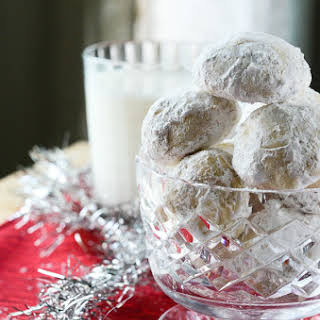Deliciously soft, buttery and melt-in-your-mouth, Russian tea cakes are the epitome of yumminess.
Also known as Mexican wedding cakes, Swedish Heirlooms, snowballs, butter balls, these delightful treats of sweetness are so easy to make. In fact, you probably have all the ingredients in your pantry right now.
In our house, we called them snowballs but whatever you call them, they remain the perfect accompaniment for all occasions.
According to Wikipedia, they were originally derived from European shortbread cookies in the Middle Ages and the basic recipe is now used all over the world. But it’s believed the name Russian Tea Cakes stuck because they were traditionally served beside Russian tea samovars.
The recipe is relatively simple generally consisting entirely of butter, flour and water along with a smidgen of vanilla and lots of ground nuts like hazelnuts, almonds, walnuts or pecans, favored by American bakers.
Rich and crumbly, these bite-sized shortbread cakes are twice-coated in confectioners’ sugar. After baking, they are rolled in powdered sugar while still hot, then coated again once they have cooled. They have become a very popular sweet delight during the winter holidays because of their powdery white, spherical appearance.
It’s difficult for me to imagine savoring these little cakes without sipping a hot cup of tea as well and these treats pair perfectly with a cup of hot tea from a Russian samovar.
A Russian samovar is a simple but effective way of preparing tea, as well as being a source of cultural pride. It’s special— like the afternoon tea ritual in Britain or the Japanese Tea Ceremony. Not only is tea the daily beverage in Russia but it is also associated with Russian hospitality — of times to savor tea leisurely with friends and family.
A samovar is essentially a big, vase-shaped kettle for containing hot water, with a tap on the side to dispense the hot water. I brought back a samovar from a trip to St. Petersburg (the real one) several years ago and it’s perfect for when lots of friends come to visit.
Samovars were traditionally heated with coal or charcoal and an internal chimney vented the smoke into the air while heating the water around it. A small teapot can be placed at the very top of the samovar to keep brewed tea warm. Nowadays newer samovars use electricity to heat tea water just the same as the British and French use an electric kettle to brew tea.
The samovar is undoubtedly at the center of Russia’s teatime culture. The richest families used samovars crafted from pure silver; samovars for the lower-classes were made from copper and brass. Today, gift shops in Russia sell elaborately enameled samovars covered in jewels or bright colors.
Russia is still one of the largest consumers of tea in the world and samovars are only brought out for special occasions. Antique samovars are often prized for their beautiful workmanship.
To make Russian Tea Cakes:
Unsalted butter: You’ll want your butter partly melted for this recipe. So about half melted.
Vanilla extract
Icing/powdered sugar
Plain/all-purpose flour
Salt
Chopped nuts: I use a mix of peanuts, almonds and walnuts. You can use ground nuts if you prefer less crunch.
Whisk together the partly melted butter, vanilla, and icing sugar until smooth and combined.
Fold in the flour and salt to form a soft, but not sticky, dough. Fold in the chopped nuts.
Roll the dough into tablespoon-sized (0.7oz) balls, and place them 2 inches apart on a baking tray lined with parchment paper or a silicone mat. Bake for 12 to 14 minutes until firm but not brown, then transfer them to a wire rack to cool slightly.
Roll the slightly hot cookies in confectioner’s sugar, and allow to cool completely on the wire rack. Once cool, roll them in confectioner’s sugar again.

